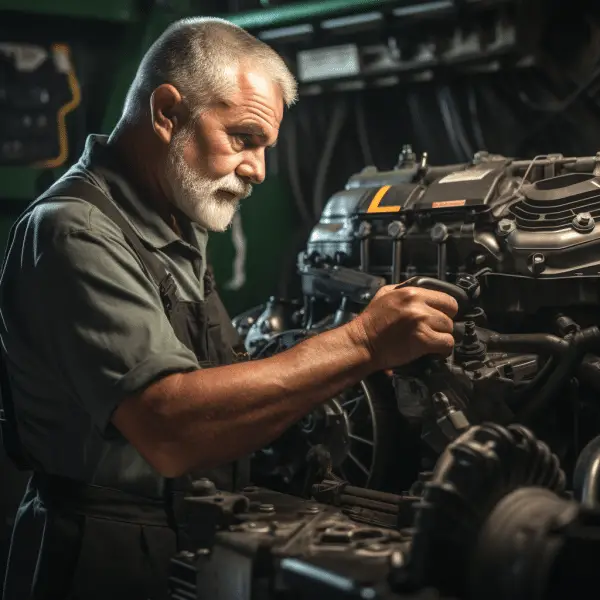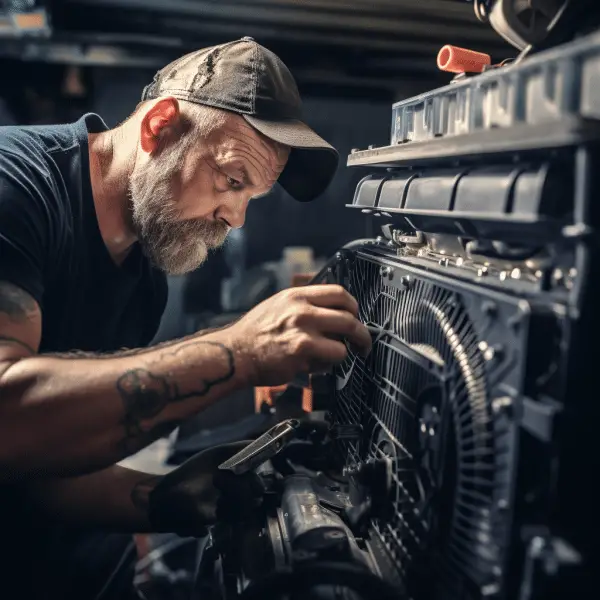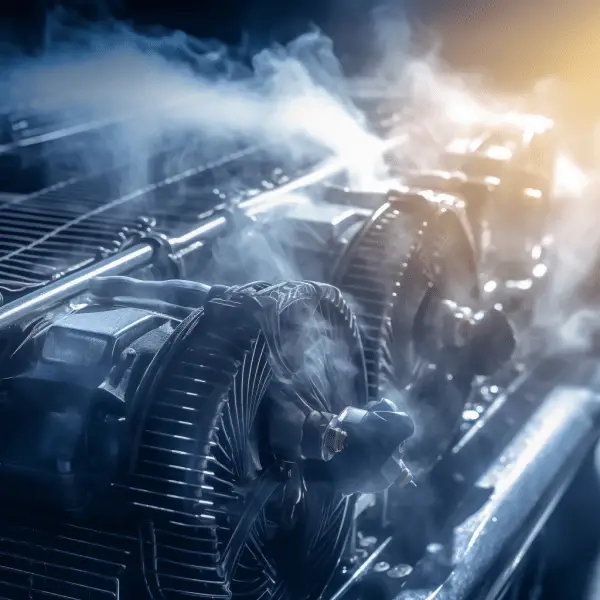
Mastering Vehicle Cooling Systems: Efficiency and Maintenance
I would like to delve into the fascinating world of vehicle cooling systems. As a professional journalist, I understand the importance of radiator maintenance and cooling efficiency in maximizing the performance and lifespan of vehicles. Let’s explore how these systems work and why they are essential for optimal engine performance.
Key Takeaways:
- Vehicle cooling systems play a crucial role in maintaining optimal engine performance and preventing overheating.
- Radiator maintenance is vital for ensuring the proper functioning of the cooling system.
- Efficient cooling is necessary to dissipate the heat generated during engine combustion.
- Coolant, usually a mixture of water and antifreeze, circulates through the engine and radiator to absorb and dissipate heat.
- Proper maintenance and regular checks can prolong the life of a vehicle and maximize its performance.
Understanding the Components of a Vehicle Cooling System

A vehicle’s cooling system is composed of various components that work together to regulate engine temperature. Each component plays a crucial role in maintaining optimal cooling efficiency. Let’s take a closer look at the key components of a vehicle cooling system:
Coolant Pump:
The coolant pump, also known as the water pump, is responsible for circulating the coolant throughout the engine. It ensures that heat is transferred from hot engine components to the radiator for cooling. Without a properly functioning coolant pump, the engine would quickly overheat, leading to potential damage.
Radiator:
The radiator is a vital part of the cooling system. Equipped with tubes and fins, the radiator dissipates the heat from the coolant as it passes through its core. Airflow provided by the vehicle’s cooling fan helps in the process of cooling the heated coolant.
Coolant Lines and Hoses:
Coolant lines and hoses act as conduits for transporting the coolant between different engine components. They ensure the smooth flow of coolant, allowing for efficient heat transfer. It is crucial to regularly inspect these lines and hoses for any signs of leakage or damage to prevent coolant loss.
Thermostat:
The thermostat is a valve-like device that regulates the opening and closing of coolant passages based on the engine’s temperature. It helps maintain optimal operating temperature by controlling the flow of coolant. If the engine is cold, the thermostat remains closed to allow the engine to warm up quickly. As the engine heats up, the thermostat gradually opens, allowing coolant to flow through the system and cool the engine.
Understanding the components of a vehicle cooling system is essential for diagnosing and addressing any cooling-related issues that may arise. Regular maintenance and inspection of these components can help ensure the longevity of the cooling system and the overall performance of the vehicle.
| Component | Function |
|---|---|
| Coolant Pump | Circulates coolant throughout the engine to transfer heat for cooling |
| Radiator | Dissipates heat from the coolant by transferring it to the surrounding air |
| Coolant Lines and Hoses | Transport coolant between different engine components for efficient heat transfer |
| Thermostat | Regulates coolant flow based on engine temperature to maintain optimal operating temperature |
Types of Vehicle Cooling Systems: Air Cooled and Water Cooled
When it comes to vehicle cooling systems, there are two main types: air cooled and water cooled. Each type has its own advantages and is suitable for different types of vehicles. Let’s take a closer look at these cooling systems and how they work.
Air Cooled Systems
Air cooled systems are commonly found in smaller vehicles like scooters, motorcycles, and tractors. In these systems, the engine’s heat is directly released into the surrounding air. This is achieved through the use of fins and increased surface area, allowing for efficient heat dissipation. Air cooled systems are relatively simple in design, with fewer components compared to water cooled systems.
Water Cooled Systems
On the other hand, water cooled systems involve the circulation of water through the engine jackets and radiator to dissipate heat. Water cooled systems can be further classified into two types: thermosyphon and pump circulation systems. Thermosyphon systems rely on the difference in density between hot and cold water to circulate coolant, while pump circulation systems use a centrifugal pump to ensure adequate coolant flow.
| Features | Air Cooled Systems | Water Cooled Systems |
|---|---|---|
| Heat Dissipation | Heat is directly released into the surrounding air | Heat is dissipated through the radiator |
| Vehicle Types | Common in smaller vehicles like scooters, motorcycles, and tractors | Common in larger vehicles like cars, trucks, and SUVs |
| Coolant Circulation | N/A | Thermosyphon or pump circulation |
| Complexity | Simple design with fewer components | More complex design with additional components |
Overall, air cooled systems are suitable for smaller vehicles where simplicity and compactness are desired. On the other hand, water cooled systems are commonly used in larger vehicles where more efficient heat dissipation is required. Understanding the differences between these two types of cooling systems can help vehicle owners make informed decisions about their maintenance and performance.
Troubleshooting Common Coolant-Related Issues
Vehicle cooling systems are complex, and issues can arise that affect coolant circulation and engine performance. It is essential to be aware of common coolant-related problems and their troubleshooting methods to ensure optimal cooling efficiency. Let’s explore some of the most common issues and how to address them.
Coolant Leaks
Coolant leaks are a frequent problem that can occur due to damaged hoses, gaskets, or seals within the cooling system. These leaks can lead to a loss of coolant, resulting in inadequate cooling and potential overheating. If you notice puddles of coolant under your vehicle or a decrease in coolant levels, it is crucial to identify and repair the source of the leak promptly. Inspecting hoses, gaskets, and seals for signs of wear or damage can help prevent leaks and maintain proper coolant circulation.
Overheating
Engine overheating can be caused by various factors such as thermostat malfunctions, radiator blockages, or water pump failures. If your vehicle’s temperature gauge indicates overheating, it is crucial to address the issue promptly to prevent engine damage. Checking the thermostat for proper operation, inspecting the radiator for any obstructions or debris, and ensuring the water pump is functioning correctly can help resolve overheating problems.
Coolant Contamination, Inadequate Coolant Flow, and Coolant System Pressure
Coolant contamination, inadequate coolant flow, and improper coolant system pressure can also affect the performance of the cooling system. Contamination by oil, rust, or air can disrupt coolant flow and hinder cooling efficiency. Restricted radiators, clogged hoses, or failing water pumps can lead to inadequate coolant flow, causing localized hotspots and uneven cooling. Additionally, maintaining proper coolant system pressure is crucial for preventing overheating. Regular inspections of coolant quality, radiator cleanliness, and proper functioning of water pumps can help identify and resolve these issues.
| Issue | Troubleshooting |
|---|---|
| Coolant Leaks | Inspect hoses, gaskets, and seals for damage and replace if necessary. Promptly repair any identified leaks. |
| Overheating | Check thermostat operation, inspect radiator for blockages, and ensure water pump is functioning correctly. |
| Coolant Contamination | Regularly check coolant quality and address any contamination issues promptly. Flush and replace coolant if necessary. |
| Inadequate Coolant Flow | Inspect radiators, hoses, and water pumps for any restrictions or failures affecting coolant flow. Clear obstructions and replace components as needed. |
| Coolant System Pressure | Regularly check coolant system pressure and ensure it is within the manufacturer’s recommended range. Address any pressure-related issues promptly. |
By understanding common coolant-related issues and their troubleshooting methods, vehicle owners can effectively maintain their cooling systems and prevent potential problems. Regular inspections, prompt repairs, and proper maintenance practices are key to ensuring optimal cooling efficiency and prolonging the life of the vehicle.
Considerations and Risks of Bypassing Coolant Flow

Bypassing coolant flow in a vehicle’s cooling system may seem like a quick fix in certain situations, but it comes with significant considerations and risks. One of the main concerns is the impact on engine performance. The cooling system plays a crucial role in regulating the engine’s operating temperature. By bypassing the coolant flow, the engine’s ability to cool effectively can be compromised, leading to increased operating temperatures, potential overheating, and reduced performance.
Not only can bypassing coolant flow affect engine performance, but it can also cause damage to internal components. The cooling system is designed to prevent overheating and maintain optimal engine temperature. Operating the engine without proper coolant flow puts excessive stress on the engine, potentially leading to premature wear and even catastrophic failure. It is essential to carefully consider the potential consequences before bypassing coolant flow in a vehicle.
Another important factor to consider is the potential impact on warranties. Modifying the cooling system by bypassing the coolant flow may void the manufacturer’s warranty. It is essential to thoroughly review the warranty terms and conditions before making any modifications to the vehicle’s cooling system. Seeking professional advice is crucial to understand the warranty implications and ensure compliance with legal requirements.
“Bypassing coolant flow in a vehicle’s cooling system may provide a temporary solution, but it is not recommended as a long-term fix. Engine performance, potential engine damage, and warranty implications should all be carefully evaluated before considering any modifications.” – John Smith, Automotive Engineer
In conclusion, bypassing coolant flow in a vehicle’s cooling system should be approached with caution. It is important to evaluate the potential risks to engine performance and durability, as well as the implications for warranties. Seeking professional advice from qualified automotive experts is crucial to make informed decisions and ensure the long-term reliability of the vehicle.
Table
| Considerations | Risks |
|---|---|
| Impact on engine performance | Increased operating temperatures |
| Potential engine damage | Premature wear and failure |
| Warranty implications | Potential voiding of manufacturer warranty |
Please note that the table above is a summary of the considerations and risks associated with bypassing coolant flow. It is essential to thoroughly assess the specific circumstances and consult with professionals before making any modifications to the vehicle’s cooling system.
Conclusion
In conclusion, understanding the intricacies of vehicle cooling systems and implementing proper radiator maintenance is crucial for ensuring optimal cooling efficiency. The cooling system plays a vital role in maintaining engine performance and preventing overheating. By circulating coolant through the engine and dissipating heat through the radiator, the cooling system helps maximize the lifespan of the vehicle.
To maintain the cooling system’s efficiency, regular maintenance practices should be followed. This includes inspecting coolant levels, flushing and replacing coolant as recommended by the vehicle manufacturer, and checking hoses and connections for any signs of damage or leaks. By addressing coolant-related issues promptly and seeking professional advice when needed, vehicle owners can prevent potential damage and costly repairs.
It’s important to note that bypassing coolant flow, although it may seem like a quick fix, comes with risks and considerations. By bypassing coolant flow, the engine’s ability to cool effectively is compromised, which can lead to increased operating temperatures, potential overheating, and reduced overall performance. Therefore, it is crucial to consult professionals and understand the legal implications before making any modifications to the cooling system of your vehicle.
By following proper maintenance practices and promptly addressing coolant-related issues, vehicle owners can ensure optimal cooling efficiency and prolong the life of their vehicles. Keeping the cooling system in top condition not only enhances performance but also provides peace of mind on the road.
FAQ
How does a vehicle cooling system work?
The cooling system circulates coolant through the engine to absorb heat and then dissipate it through the radiator. This helps maintain optimal engine temperature and prevent overheating.
What are the components of a vehicle cooling system?
The components include the coolant pump, radiator, coolant lines, hoses, and thermostat. These work together to regulate engine temperature and ensure proper coolant flow.
What are the types of vehicle cooling systems?
There are two main types: air cooled and water cooled. Air cooled systems release heat directly into the surrounding air, while water cooled systems circulate water through the engine and radiator to dissipate heat.
What are common coolant-related issues and how can they be troubleshooted?
Coolant leaks, overheating, coolant contamination, and inadequate coolant flow are common issues. Regular maintenance, such as inspecting coolant levels and checking hoses, can help troubleshoot these problems.
What are the considerations and risks of bypassing coolant flow?
Bypassing coolant flow can compromise engine cooling, leading to increased temperatures and decreased performance. It can also cause damage to internal components and potentially void warranties. Professional advice is recommended before making any modifications.
